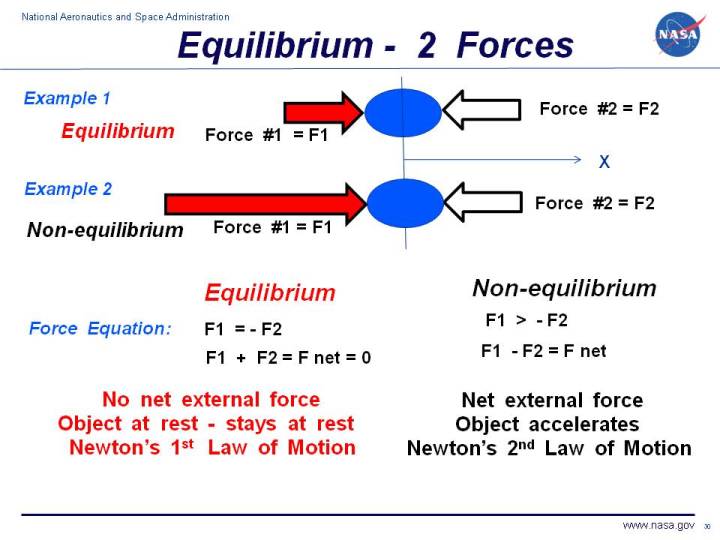
A very basic concept when dealing with
forces
is the idea of equilibrium or balance.
In general, an object can be acted on by several forces
at the same time.
A force is a
vector quantity
which means
that it has both a magnitude (size) and a direction associated with it.
If the size and direction of the forces acting on an object are
exactly balanced, then there is no net force acting on the object
and the object is said to be in equilibrium.
Because there is no net force acting on an object in equilibrium,
then from Newton's
first law
of motion, an object at rest will stay at rest, and an object in motion
will stay in motion.
Let us start with the simplest example of two forces acting on an object.
Then we will show examples of
three forces acting on a glider, and
four forces acting on a powered aircraft.
In Example 1 on the slide, we show a blue ball that is being pushed by
two forces, labeled Force #1 F1 and Force #2 F2. Remember that
forces are vector quantities and direction is important.
Two forces with the same magnitude but different directions
are not equal forces. In fact,
F1 = - F2
for the coordinate system shown
with the letter X below the ball. If we sum up the forces acting on the ball,
we obtain the force equation on the left:
F1 + F2 = F net = 0
where F net is the net force acting on the ball.
Because the net force is equal to zero, the forces in Example 1 are
acting in equilibrium.
There is no net force acting on the ball in Example 1. Since the ball is initially at rest
(velocity equals zero), the ball will remain at rest according to Newton's
first law
of motion. If the ball was travelling with a uniform velocity, it would continue travelling
at the same velocity.
In Example 2, we have increased the magnitude of Force #1 so that it is much greater
than Force #2. The forces are no longer in equilibrium.
The force equation remains the same, but the net force is not equal to zero.
The magnitude of the net force is given by:
F1 > - F2
F1 + F2 = F net
|F net| = |F1| - |F2|
where the "| |" symbols indicate the magnitude of the quantity included between the ends.
The direction of the net force would be in the positive X direction because F1
is greater then F2.
According to Newton's
second law
of motion, the ball would begin to accelerate to the right. Because there is a net force in
Example 2, the forces are not in equilibrium.
Navigation..



- Beginner's Guide Home Page
|
